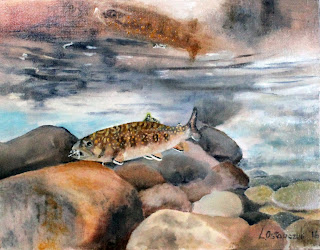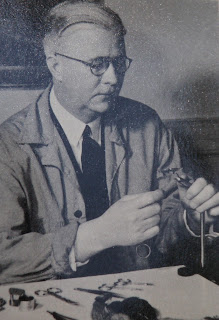Legendary Esopus
Creek pools: Below are landscapes of three
legendary Esopus Creek pools: the Trestle, Jennings Pool, and Mother’s Pool, plus stories of big trout.
The
historic railroad trestle over the Esopus, downstream of Boiceville, dates back
to the very early 1900s--- the Ulster and Delaware Railroad Company, a rail line
known as “The Only All-Rail Route to the Catskill Mountains.” At its pinnacle the U&D ran from Kingston
on the Hudson through four Catskill counties before terminating in Oneonta.
In
1932 U&D became the Catskill Mountain Branch of New York Central, which later merged
with Pennsylvania Railroad in 1968 to form Penn Central only to eventually go
bankrupt in 1970. In 1976 Conrail---
Consolidated Rail Corporation--- was created by the U.S. government and assumed
ownership of the rail line. However, the
last Conrail freight train departed Kingston on September 28th, 1976 headed to
Stamford before returning to Kingston on October 2nd.
In
1979 Ulster County purchased the 38.6 mile section of rail from Kingston to the
county line at Highmount. Then in
1982 the rail line was leased to the Catskill Mountain Railroad--- CMRR. At that time the Trestle officially became
CMRR Bridge C30, the last name change from its original U&D C30
designation.
Before
the Trestle was destroyed by Hurricane Irene in 2011, it served as a wooden
footpath for many anglers travelling to and from the Chimney Hole at the mouth
of the Ashokan Reservoir downstream. However,
trout fishermen weren’t the only users of this lost deck plate girder
bridge. On several late June afternoons
local Onteora High School students could be seen jumping from the structure
into the deep sections of the cool Esopus Creek below.
Perhaps
the fondest personal memory of the Trestle occurred on April 13th,
2010 when in the shadows of the dilapidated railroad bridge, one lucky
flyfisher caught a silvery twenty-two inch Ashokan Reservoir run brown trout,
the first trout he ever landed on his Black Beauty Heddon cane rod.
Trestle,
U&D C30, 11x14 (DtC):
Jennings
Pool in Mount Tremper bears the name of noted fly tyer and fisher Preston J. Jennings. Jennings was a sales engineer who lived in
Brooklyn, NY, but often fished the Catskill while doing research for his book,
first published by Derrydale Press in 1935, A Book of Trout Flies.
The
late Ernest Schwiebert, also a noted trout fisher, wrote the following about
Jennings and this book, “The work of Jennings set the standard of excellence
that has measured all subsequent work on fly-fishing entomology.”
Among
other trout streams, Jennings extensively studied aquatic insect life on the Esopus Creek for his manuscript. He often stayed in
Woodstock while fishing the Esopus, but also visited and tied flies for guests
staying at Kahil’s Rainbow Lodge on UC 212 in Mount Tremper. There he befriended Arnold Gingrich who would
later write glowingly about the author.
Among the regulars at Rainbow Lodge, Jennings Isonychia Nymph came to be known as the “Esopus Nymph”.
Preston Jennings tying a fly:
Jennings
often fished the pool couched between the NY 28 bridge and the old red steel
bridge at Mount Pleasant Road. Years ago
this was another structure that young local hooligans could be seen jumping
from into the Esopus Creek below.
Jennings Pool, 11x14:
Once
again, personal fond memories of Jennings Pool involve mammoth brown trout
hooked and lost here; the latest occurrence the morning after the NY Mets lost
the 2015 World Series, just piling up miseries of what could have been.
Mother’s
Pool is located off Plank Road--- Old Route 28, just downstream of the hamlet
of Phoenicia, tubing capital of the Catskills.
Local angling lore tells how this pool was named after the mother of Esopus
Creek guide and Dean of the stream, Ray Smith. Ray’s mother--- Agnes Moon Smith--- trout fished also, and according to local legend when she
was nowhere to be found around the house, the answer to the question of “Where
is she?” was “Mother’s Pool.”
This
pool was also the former home of Old Bess, a 9½ pound brown caught here by
Larry Decker on April 29th, 1955.
Decker seduced the massive brown trout, measuring 30¾ inches long, while
fishing minnows on his Payne fly rod!
Larry
Decker and Old Bess coming off Mother’s Pool:
Mother’s
Pool, soft light 11x14 (Sold):







































